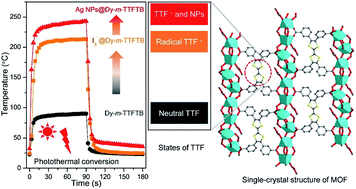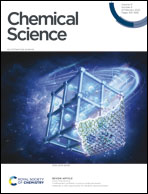Enhancing the photothermal conversion of tetrathiafulvalene-based MOFs by redox doping and plasmon resonance†
Abstract
Near-infrared (NIR) photothermal materials hold great promise for use in several applications, particularly in photothermal therapy, diagnosis, and imaging. However, current NIR responsive materials often show narrow absorption bands and low absorption efficiency, and have long response times. Herein, we demonstrate that the NIR absorption of tetrathiafulvalene-based metal–organic frameworks (MOFs) can be tuned by redox doping and using plasmonic nanoparticles. In this work, a MOF containing redox-active tetrathiafulvalene (TTF) units and Dy-carboxylate chains was constructed, Dy-m-TTFTB. The NIR absorption of the as-synthesized Dy-m-TTFTB was further enhanced by Ag+ or I2 oxidation, transforming the neutral TTF into a TTF˙+ radical state. Interestingly, treatment with Ag+ not only generated TTF˙+ radicals, but it also formed Ag nanoparticles (NPs) in situ within the MOF pores. With both TTF˙+ radicals and Ag NPs, Ag NPs@Dy-m-TTFTB was shown to exhibit a wide range of absorption wavelengths (200–1000 nm) and also a high NIR photothermal conversion. When the system was irradiated with an 808 nm laser (energy power of 0.7 W cm−2), Ag NPs@Dy-m-TTFTB showed a sharp temperature increase of 239.8 °C. This increase was higher than that of pristine Dy-m-TTFTB (90.1 °C) or I2 treated I3−@Dy-m-TTFTB (213.0 °C).

- This article is part of the themed collection: Metal organic frameworks and porous polymers


 Please wait while we load your content...
Please wait while we load your content...